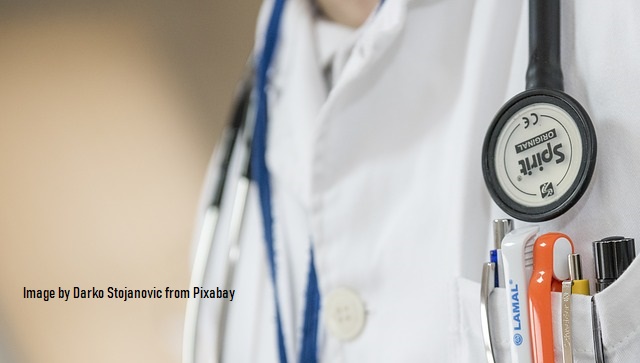The Stethoscope Is Not Just a Prop

Stock photos of “healthcare workers” who attend patients—physicians are no longer distinguishable—usually feature a stethoscope draped around the neck.
But some, such as cardiologist Eric Topol, consider the stethoscope obsolete, nothing more than a pair of “rubber tubes.”
The most important part of the stethoscope is the part between the ears. But some think that will be replaced by artificial intelligence, and the rubber tubes by sophisticated electronic gizmos costing at least ten times as much as the humble stethoscope.
High tech is wonderful and increasingly capable, but if the stethoscope is dying, so is the art of clinical medicine.
The proper use of the stethoscope requires the doctor to touch, listen to the patient, and spend some time with a living person, not a computer. Patient and physician must cooperate: “Stop breathing,” “Take a big deep breath,” “Lean forward,” and so on.
It may be true, as Dr. James Thomas said, that graduates in internal medicine and emergency medicine miss as many as half of murmurs using a stethoscope. There are several reasons for this. One is not taking enough time to listen in a quiet room, and failing to perform the special maneuvers required to bring out an otherwise inaudible murmur (lean forward and exhale fully, turn onto your left side, squat then stand up, etc.).
The other is inadequate training. There are excellent recordings of heart sounds and murmurs, which of course would take time away from the time-devouring electronic medical record or “systems-based” medicine. And a recording is not the same thing as a live patient. Much of today’s teaching in physical diagnosis may be by “patient instructors”—paid actors pretending to be patients, who are evaluating the students as the students examine them. Rounds may be in a conference room, focused on the electronic record, instead of at the bedside.
In the old days, all the members of the team got to examine a real patient who had an interesting finding, with the patient’s permission and under the supervision of an attending physician. It seemed to me that patients usually enjoyed being the center of attention and the star of the show, and hearing the professor discuss their case. We learned how to help patients to sit up, and about hairy chests, layers of extra insulation, noisy lung sounds, shortness of breath, and other impediments to an easy examination.
The stethoscope is not just for heart murmurs. It’s for finding subtleties in careful, slow measurement of the blood pressure. It’s for extra or abnormal heart sounds. One can sometimes hear evidence of vascular problems inside the skull, or in the arteries supplying the brain, kidneys, or limbs. Or signs of intestinal obstruction. One can check to make sure a breathing tube is in the right place.
I don’t know of any bedside technologic wonders for examining the lungs. The stethoscope can detect sensitive signs of heart failure, pneumonia, fluid in the chest, collapsed lung, or airway obstruction. One can listen frequently to monitor changes in the patient’s status—much more efficiently than bringing the portable x-ray machine around.
The stethoscope works even when the power is off, the batteries are dead, the computer is down, or some circuit in the ultrasound device is malfunctioning. It works in facilities too poor to have the latest technology, or with patients who can’t afford to pay for a more expensive examination.
The stethoscope has tremendous capabilities in trained hands. Patients might want to evaluate whether they have a clinician who knows how to use it or is just carrying around a prop or status symbol. If you have symptoms suggestive of a heart or lung problem, does the doctor listen to all the lung fields—upper, mid, and lower, front and back? To at least four places for heart sounds? Are you asked to cough, say “e,” whisper something, take deep breaths or slow quiet ones, or do other maneuvers if something in the history or examination suggests a possible problem? Is the tv off, and are visitors asked to be quiet?
Everybody including doctors loves fancy technology. But before we toss out the old reliable tools, backed by two centuries of experience, how about some serious comparative studies like those the proponents of evidence-based medicine constantly demand?
© All rights reserved.


Leave a Reply
Want to join the discussion?Feel free to contribute!